2023 FORD BRONCO SPORT ESP
[x] Cancel search: ESPPage 315 of 516

GENERAL INFORMATION
Use only approved wheel and tire sizes.Using other sizes could damage yourvehicle. If you change the diameter of thetires from what is fitted at the factory, thespeedometer may not display the correctspeed. If you intend to change the size ofthe wheels from what was fitted by themanufacturer, you can check the suitabilitywith your dealer.
Additional information related to thefunctionality and maintenance of your tirescan be found later in this chapter. See TireCare (page 313).
You can find the recommended tireinflation pressures on the Tire Label, whichis on the B-pillar or the edge of the driverdoor. You can also find this information onthe Safety Compliance Certification Label,affixed to either the door hinge pillar,door-latch post, or the door edge thatmeets the door latch post, next to thedriver seating position.
We strongly recommend maintaining thesetire pressures at all times. Failure to followthe tire pressure recommendations cancause uneven treadwear patterns, reducedfuel economy, and adversely affect theway your vehicle handles.
Note:Check and set the tire pressure at theambient temperature in which you areintending to drive your vehicle and when thetires are cold.
Note:Check your tire pressures at leastonce per month.
If your vehicle has a spare tire, set thepressure to the highest value given for yourvehicle and tire size combination.
Notice to Utility Vehicle and TruckOwners
WARNING: Utility vehicles have asignificantly higher rollover rate thanother types of vehicles.
WARNING: Vehicles with a highercenter of gravity (utility and four-wheeldrive vehicles) handle differently thanvehicles with a lower center of gravity(passenger cars). Avoid sharp turns,excessive speed and abrupt steering inthese vehicles. Failure to drive cautiouslyincreases the risk of losing control of yourvehicle, vehicle rollover, personal injuryand death.
WARNING: In a rollover crash, anunbelted person is significantly morelikely to die than a person wearing aseatbelt.
WARNING: Do not becomeoverconfident in the ability of four-wheeldrive vehicles. Although a four-wheeldrive vehicle may accelerate better thana two-wheel drive vehicle in low tractionsituations, it won't stop any faster thantwo-wheel drive vehicles. Always driveat a safe speed.
Utility vehicles and trucks handledifferently than passenger cars in thevarious driving conditions that areencountered on streets, highways andoff-road. Utility vehicles and trucks are notdesigned for cornering at speeds as highas passenger cars any more than low-slungsports cars are designed to performsatisfactorily under off-road conditions.
311
2023 Bronco Sport (CHD) Canada/United States of America, enUSA, Edition date: 202208, First-PrintingWheels and Tires
Page 316 of 516
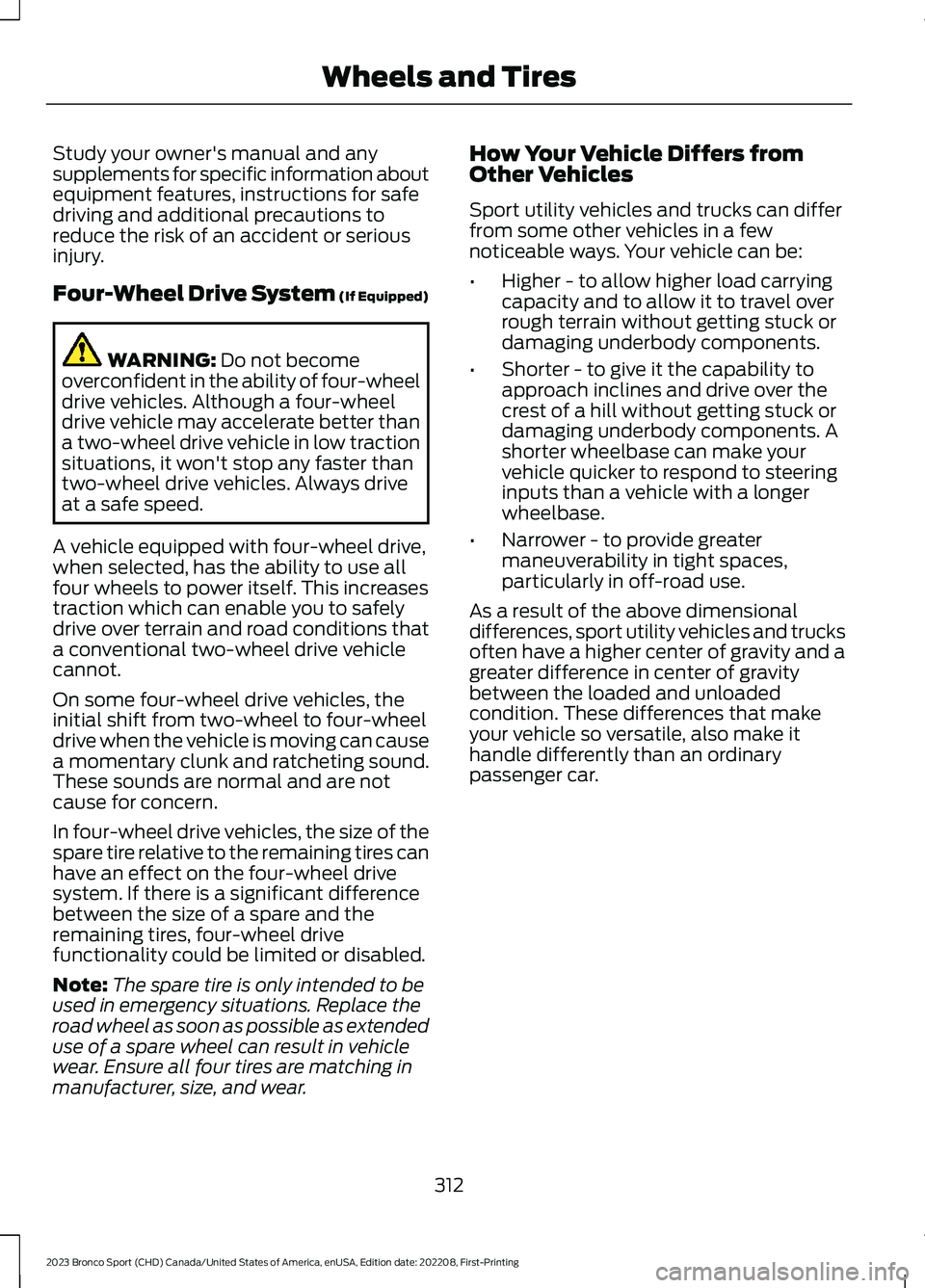
Study your owner's manual and anysupplements for specific information aboutequipment features, instructions for safedriving and additional precautions toreduce the risk of an accident or seriousinjury.
Four-Wheel Drive System (If Equipped)
WARNING: Do not becomeoverconfident in the ability of four-wheeldrive vehicles. Although a four-wheeldrive vehicle may accelerate better thana two-wheel drive vehicle in low tractionsituations, it won't stop any faster thantwo-wheel drive vehicles. Always driveat a safe speed.
A vehicle equipped with four-wheel drive,when selected, has the ability to use allfour wheels to power itself. This increasestraction which can enable you to safelydrive over terrain and road conditions thata conventional two-wheel drive vehiclecannot.
On some four-wheel drive vehicles, theinitial shift from two-wheel to four-wheeldrive when the vehicle is moving can causea momentary clunk and ratcheting sound.These sounds are normal and are notcause for concern.
In four-wheel drive vehicles, the size of thespare tire relative to the remaining tires canhave an effect on the four-wheel drivesystem. If there is a significant differencebetween the size of a spare and theremaining tires, four-wheel drivefunctionality could be limited or disabled.
Note:The spare tire is only intended to beused in emergency situations. Replace theroad wheel as soon as possible as extendeduse of a spare wheel can result in vehiclewear. Ensure all four tires are matching inmanufacturer, size, and wear.
How Your Vehicle Differs fromOther Vehicles
Sport utility vehicles and trucks can differfrom some other vehicles in a fewnoticeable ways. Your vehicle can be:
•Higher - to allow higher load carryingcapacity and to allow it to travel overrough terrain without getting stuck ordamaging underbody components.
•Shorter - to give it the capability toapproach inclines and drive over thecrest of a hill without getting stuck ordamaging underbody components. Ashorter wheelbase can make yourvehicle quicker to respond to steeringinputs than a vehicle with a longerwheelbase.
•Narrower - to provide greatermaneuverability in tight spaces,particularly in off-road use.
As a result of the above dimensionaldifferences, sport utility vehicles and trucksoften have a higher center of gravity and agreater difference in center of gravitybetween the loaded and unloadedcondition. These differences that makeyour vehicle so versatile, also make ithandle differently than an ordinarypassenger car.
312
2023 Bronco Sport (CHD) Canada/United States of America, enUSA, Edition date: 202208, First-PrintingWheels and Tires
Page 317 of 516
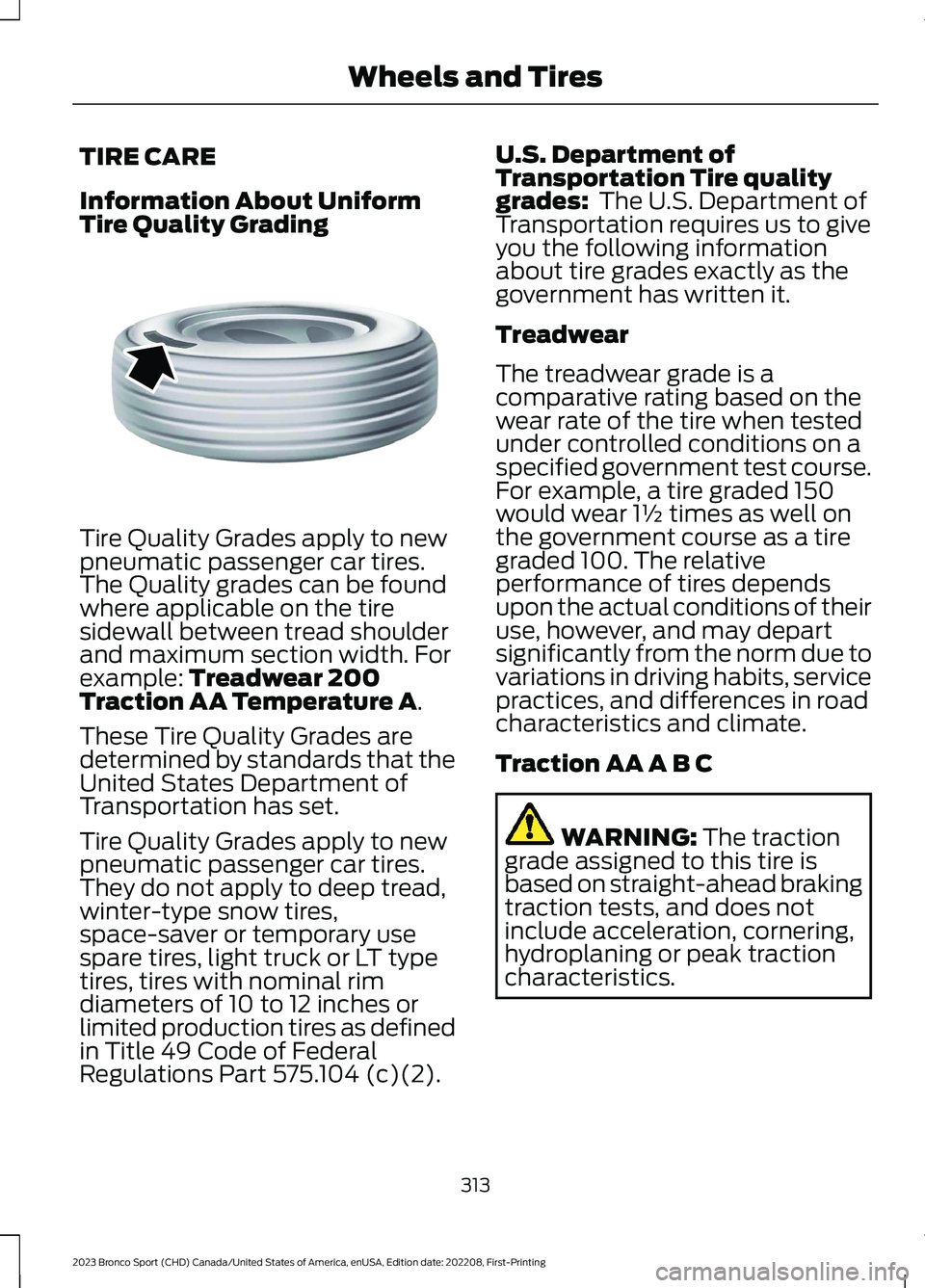
TIRE CARE
Information About UniformTire Quality Grading
Tire Quality Grades apply to newpneumatic passenger car tires.The Quality grades can be foundwhere applicable on the tiresidewall between tread shoulderand maximum section width. Forexample: Treadwear 200Traction AA Temperature A.
These Tire Quality Grades aredetermined by standards that theUnited States Department ofTransportation has set.
Tire Quality Grades apply to newpneumatic passenger car tires.They do not apply to deep tread,winter-type snow tires,space-saver or temporary usespare tires, light truck or LT typetires, tires with nominal rimdiameters of 10 to 12 inches orlimited production tires as definedin Title 49 Code of FederalRegulations Part 575.104 (c)(2).
U.S. Department ofTransportation Tire qualitygrades: The U.S. Department ofTransportation requires us to giveyou the following informationabout tire grades exactly as thegovernment has written it.
Treadwear
The treadwear grade is acomparative rating based on thewear rate of the tire when testedunder controlled conditions on aspecified government test course.For example, a tire graded 150would wear 1½ times as well onthe government course as a tiregraded 100. The relativeperformance of tires dependsupon the actual conditions of theiruse, however, and may depart
significantly from the norm due tovariations in driving habits, servicepractices, and differences in roadcharacteristics and climate.
Traction AA A B C
WARNING: The tractiongrade assigned to this tire isbased on straight-ahead brakingtraction tests, and does notinclude acceleration, cornering,hydroplaning or peak tractioncharacteristics.
313
2023 Bronco Sport (CHD) Canada/United States of America, enUSA, Edition date: 202208, First-PrintingWheels and TiresE142542
Page 318 of 516
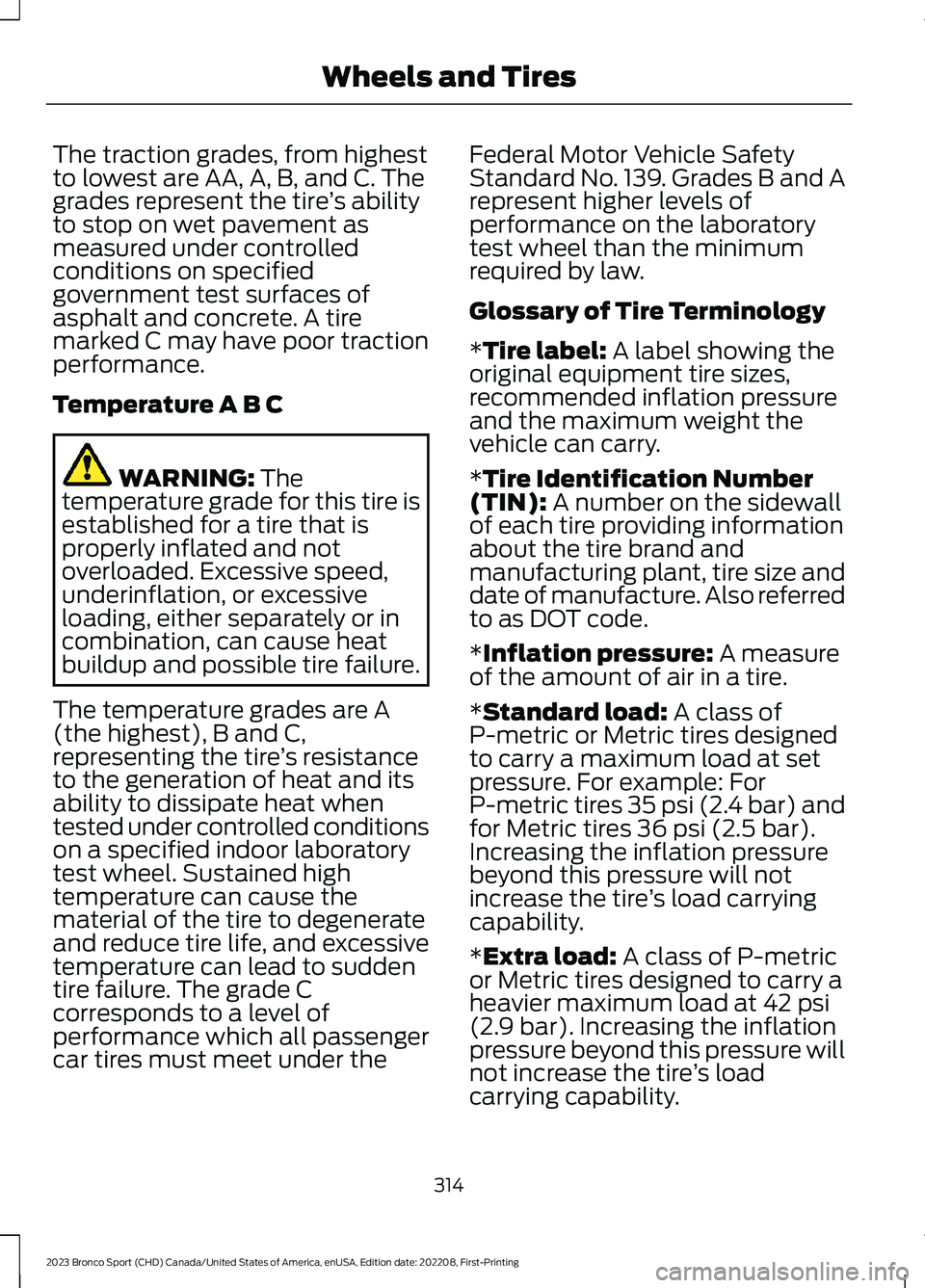
The traction grades, from highestto lowest are AA, A, B, and C. Thegrades represent the tire’s abilityto stop on wet pavement asmeasured under controlledconditions on specifiedgovernment test surfaces ofasphalt and concrete. A tiremarked C may have poor tractionperformance.
Temperature A B C
WARNING: Thetemperature grade for this tire isestablished for a tire that isproperly inflated and notoverloaded. Excessive speed,underinflation, or excessiveloading, either separately or incombination, can cause heatbuildup and possible tire failure.
The temperature grades are A(the highest), B and C,representing the tire’s resistanceto the generation of heat and itsability to dissipate heat whentested under controlled conditionson a specified indoor laboratorytest wheel. Sustained hightemperature can cause thematerial of the tire to degenerateand reduce tire life, and excessivetemperature can lead to suddentire failure. The grade Ccorresponds to a level ofperformance which all passengercar tires must meet under the
Federal Motor Vehicle SafetyStandard No. 139. Grades B and Arepresent higher levels ofperformance on the laboratorytest wheel than the minimumrequired by law.
Glossary of Tire Terminology
*Tire label: A label showing theoriginal equipment tire sizes,recommended inflation pressureand the maximum weight thevehicle can carry.
*Tire Identification Number(TIN): A number on the sidewallof each tire providing informationabout the tire brand andmanufacturing plant, tire size anddate of manufacture. Also referredto as DOT code.
*Inflation pressure: A measureof the amount of air in a tire.
*Standard load: A class ofP-metric or Metric tires designedto carry a maximum load at setpressure. For example: ForP-metric tires 35 psi (2.4 bar) andfor Metric tires 36 psi (2.5 bar).Increasing the inflation pressurebeyond this pressure will notincrease the tire’s load carryingcapability.
*Extra load: A class of P-metricor Metric tires designed to carry aheavier maximum load at 42 psi(2.9 bar). Increasing the inflationpressure beyond this pressure willnot increase the tire’s loadcarrying capability.
314
2023 Bronco Sport (CHD) Canada/United States of America, enUSA, Edition date: 202208, First-PrintingWheels and Tires
Page 331 of 516
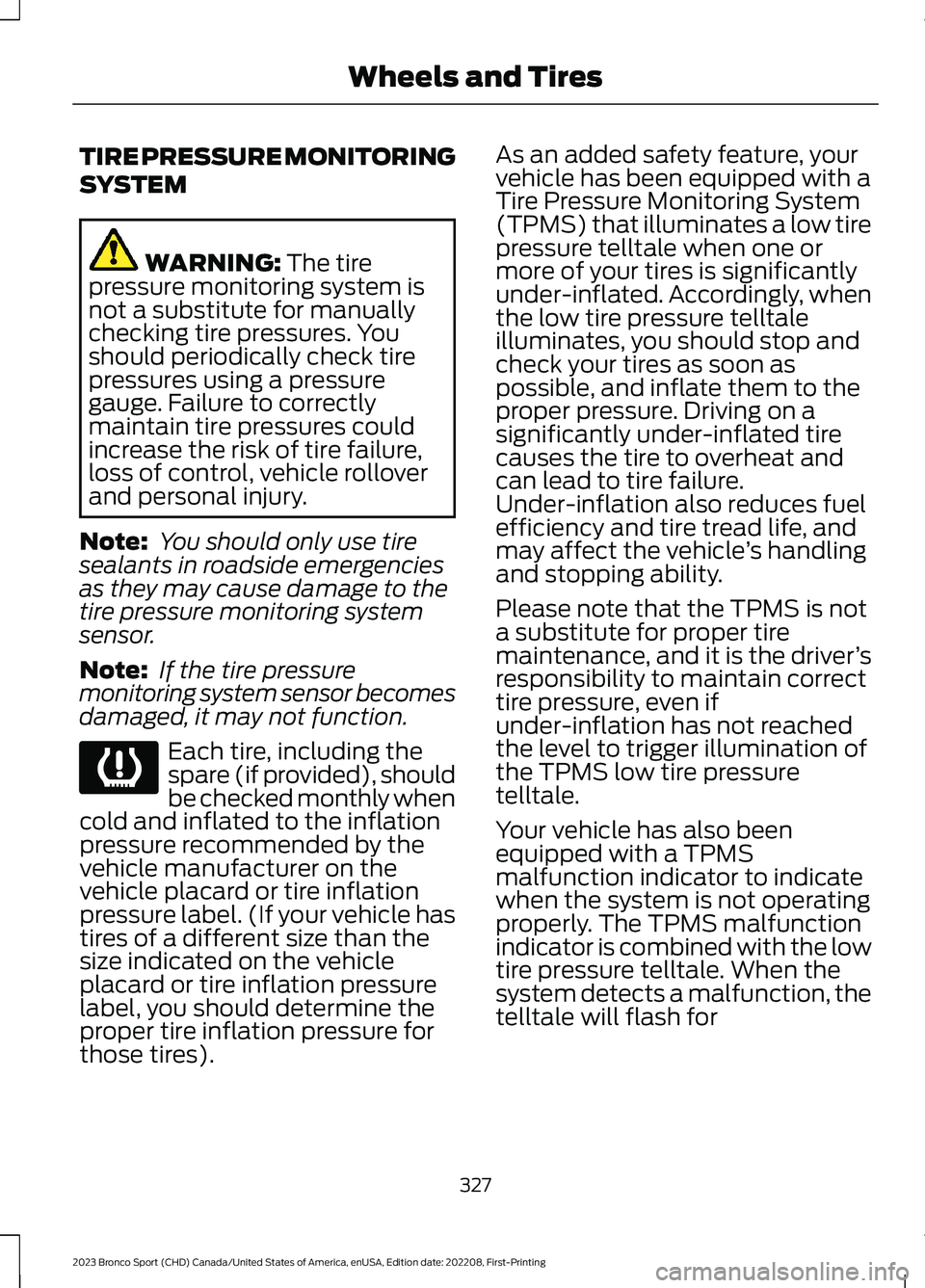
TIRE PRESSURE MONITORING
SYSTEM
WARNING: The tirepressure monitoring system isnot a substitute for manuallychecking tire pressures. Youshould periodically check tirepressures using a pressuregauge. Failure to correctlymaintain tire pressures couldincrease the risk of tire failure,loss of control, vehicle rolloverand personal injury.
Note: You should only use tiresealants in roadside emergenciesas they may cause damage to thetire pressure monitoring systemsensor.
Note: If the tire pressuremonitoring system sensor becomesdamaged, it may not function.
Each tire, including thespare (if provided), shouldbe checked monthly whencold and inflated to the inflationpressure recommended by thevehicle manufacturer on thevehicle placard or tire inflationpressure label. (If your vehicle hastires of a different size than thesize indicated on the vehicleplacard or tire inflation pressurelabel, you should determine theproper tire inflation pressure forthose tires).
As an added safety feature, yourvehicle has been equipped with aTire Pressure Monitoring System(TPMS) that illuminates a low tirepressure telltale when one ormore of your tires is significantlyunder-inflated. Accordingly, whenthe low tire pressure telltaleilluminates, you should stop andcheck your tires as soon aspossible, and inflate them to theproper pressure. Driving on asignificantly under-inflated tirecauses the tire to overheat andcan lead to tire failure.Under-inflation also reduces fuelefficiency and tire tread life, andmay affect the vehicle’s handlingand stopping ability.
Please note that the TPMS is nota substitute for proper tiremaintenance, and it is the driver’sresponsibility to maintain correcttire pressure, even ifunder-inflation has not reachedthe level to trigger illumination ofthe TPMS low tire pressuretelltale.
Your vehicle has also beenequipped with a TPMSmalfunction indicator to indicatewhen the system is not operatingproperly. The TPMS malfunctionindicator is combined with the lowtire pressure telltale. When thesystem detects a malfunction, thetelltale will flash for
327
2023 Bronco Sport (CHD) Canada/United States of America, enUSA, Edition date: 202208, First-PrintingWheels and TiresE139232
Page 332 of 516
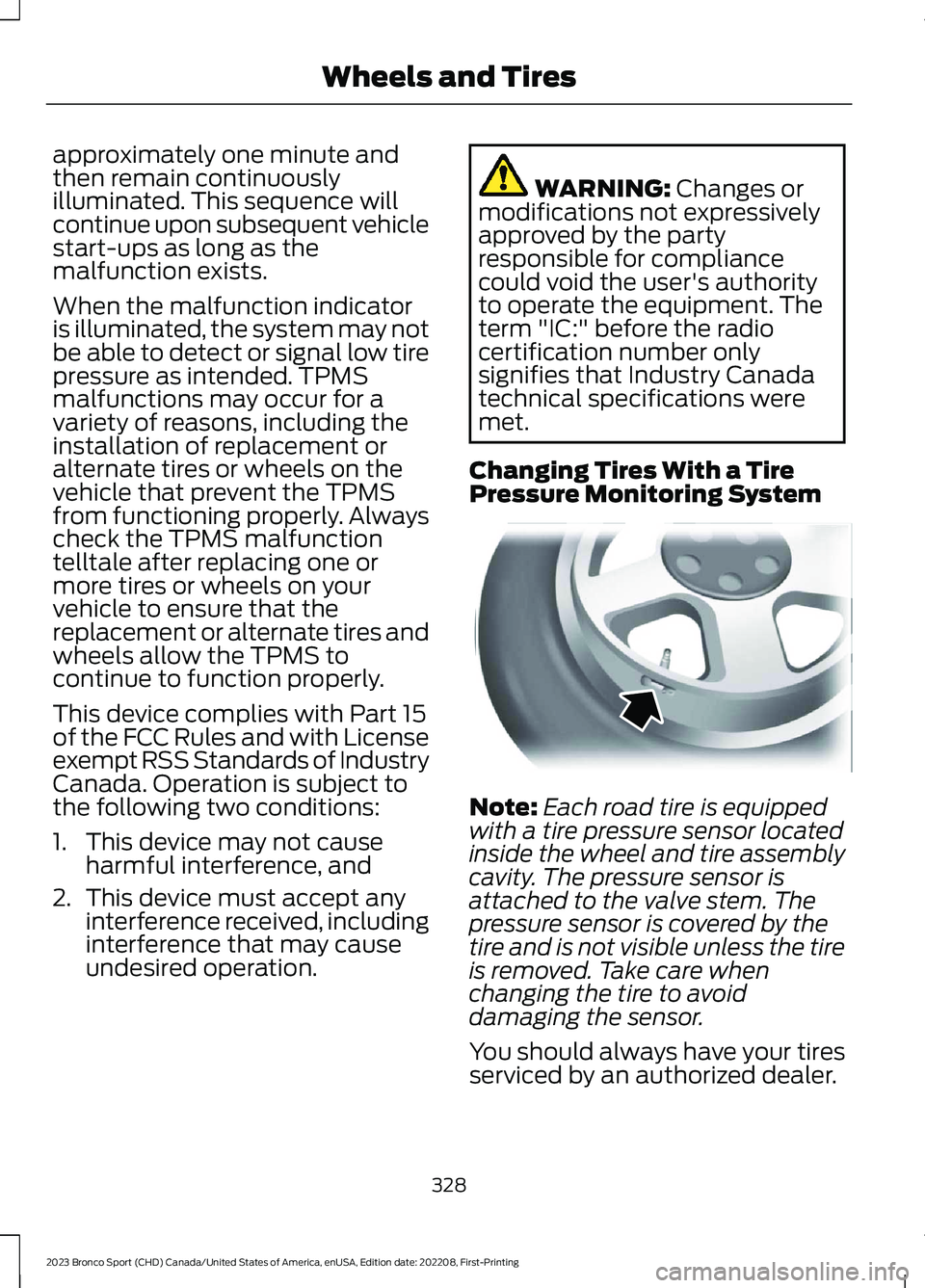
approximately one minute andthen remain continuouslyilluminated. This sequence willcontinue upon subsequent vehiclestart-ups as long as themalfunction exists.
When the malfunction indicatoris illuminated, the system may notbe able to detect or signal low tirepressure as intended. TPMSmalfunctions may occur for avariety of reasons, including theinstallation of replacement oralternate tires or wheels on thevehicle that prevent the TPMSfrom functioning properly. Alwayscheck the TPMS malfunctiontelltale after replacing one ormore tires or wheels on yourvehicle to ensure that thereplacement or alternate tires andwheels allow the TPMS tocontinue to function properly.
This device complies with Part 15of the FCC Rules and with Licenseexempt RSS Standards of IndustryCanada. Operation is subject tothe following two conditions:
1.This device may not causeharmful interference, and
2.This device must accept anyinterference received, includinginterference that may causeundesired operation.
WARNING: Changes ormodifications not expressivelyapproved by the partyresponsible for compliancecould void the user's authorityto operate the equipment. Theterm "IC:" before the radiocertification number onlysignifies that Industry Canadatechnical specifications weremet.
Changing Tires With a TirePressure Monitoring System
Note:Each road tire is equippedwith a tire pressure sensor locatedinside the wheel and tire assemblycavity. The pressure sensor isattached to the valve stem. Thepressure sensor is covered by thetire and is not visible unless the tireis removed. Take care whenchanging the tire to avoiddamaging the sensor.
You should always have your tiresserviced by an authorized dealer.
328
2023 Bronco Sport (CHD) Canada/United States of America, enUSA, Edition date: 202208, First-PrintingWheels and TiresE142549
Page 335 of 516
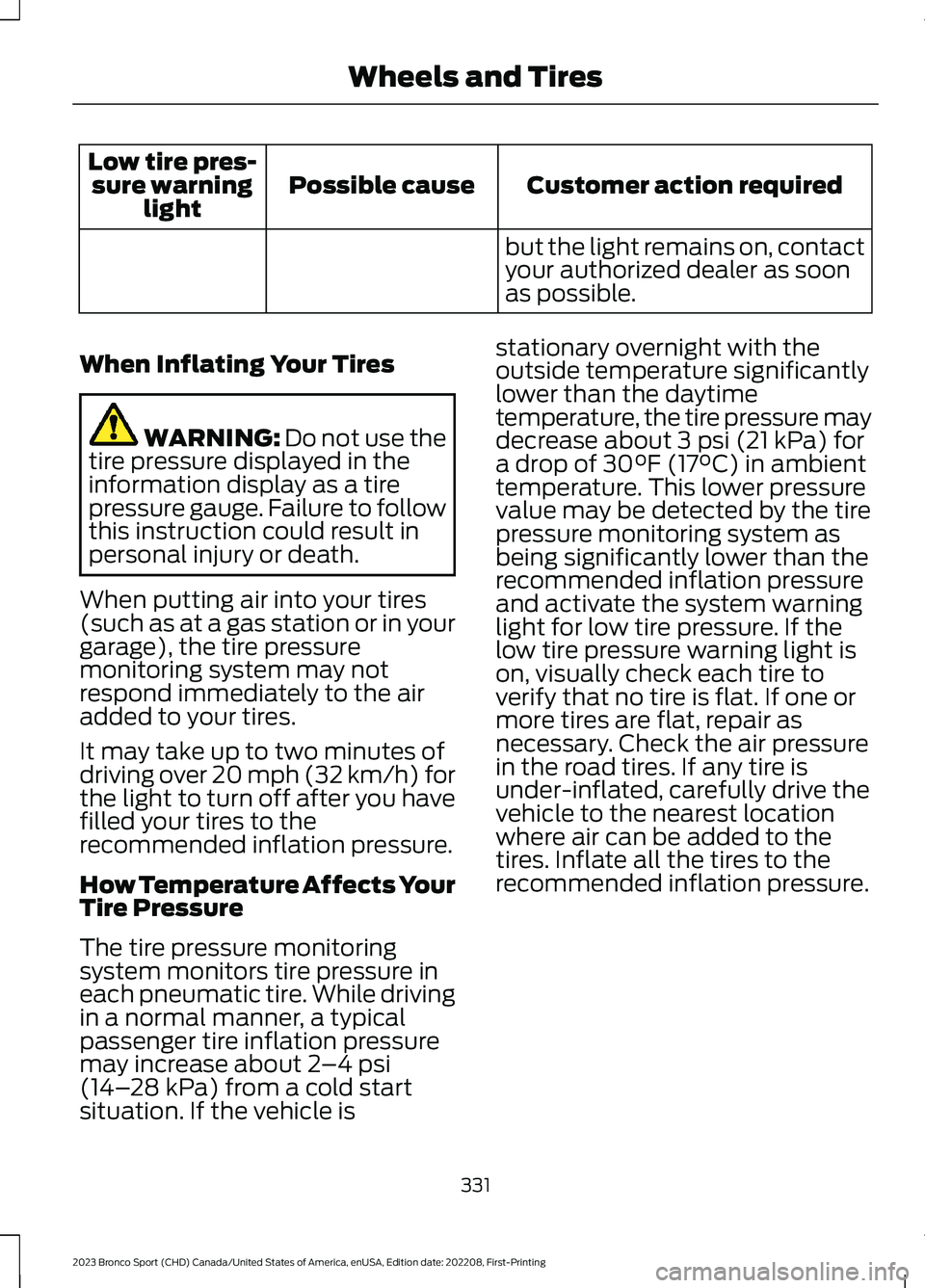
Customer action requiredPossible causeLow tire pres-sure warninglight
but the light remains on, contactyour authorized dealer as soonas possible.
When Inflating Your Tires
WARNING: Do not use thetire pressure displayed in theinformation display as a tirepressure gauge. Failure to followthis instruction could result inpersonal injury or death.
When putting air into your tires(such as at a gas station or in yourgarage), the tire pressuremonitoring system may notrespond immediately to the airadded to your tires.
It may take up to two minutes ofdriving over 20 mph (32 km/h) forthe light to turn off after you havefilled your tires to therecommended inflation pressure.
How Temperature Affects YourTire Pressure
The tire pressure monitoringsystem monitors tire pressure ineach pneumatic tire. While drivingin a normal manner, a typicalpassenger tire inflation pressuremay increase about 2–4 psi(14–28 kPa) from a cold startsituation. If the vehicle is
stationary overnight with theoutside temperature significantlylower than the daytimetemperature, the tire pressure maydecrease about 3 psi (21 kPa) fora drop of 30°F (17°C) in ambienttemperature. This lower pressurevalue may be detected by the tirepressure monitoring system asbeing significantly lower than therecommended inflation pressureand activate the system warninglight for low tire pressure. If thelow tire pressure warning light ison, visually check each tire toverify that no tire is flat. If one ormore tires are flat, repair asnecessary. Check the air pressurein the road tires. If any tire isunder-inflated, carefully drive thevehicle to the nearest locationwhere air can be added to thetires. Inflate all the tires to therecommended inflation pressure.
331
2023 Bronco Sport (CHD) Canada/United States of America, enUSA, Edition date: 202208, First-PrintingWheels and Tires
Page 338 of 516

WARNING: To help prevent yourvehicle from moving when changing awheel, shift the transmission into park(P), set the parking brake and use anappropriate block or wheel chock tosecure the wheel diagonally opposite tothe wheel being changed. For example,when changing the front left wheel,place an appropriate block or wheelchock on the right rear wheel.
WARNING: Only use the jackprovided as original equipment with yourvehicle.
WARNING: Failure to follow theseguidelines could result in an increasedrisk of loss of vehicle control, injury ordeath.
WARNING: Only use the specifiedjacking points. If you use any otherlocations you could damage vehiclecomponents, such as brake lines.
WARNING: Never place anythingbetween the vehicle jack and yourvehicle.
WARNING: Never place anythingbetween the vehicle jack and the ground.
WARNING: Do not attempt tochange a tire on the side of the vehicleclose to moving traffic. Pull far enoughoff the road to not obstruct the flow oftraffic and avoid the danger of being hitwhen operating the jack or changing thewheel.
Note:The jack does not requiremaintenance or additional lubrication overthe service life of your vehicle.
1.Park on a level surface, set the parkingbrake and activate the hazard flashers.
2.Apply parking brake, place thetransmission in park (P). Turn theengine off.
3.Lift and remove the carpeted cargoarea floor to access the spare tire andjack.
4.Remove the wing nut that secures thespare tire by turning itcounterclockwise.
5.Remove the spare tire, jack, andwrench from the spare tirecompartment.
6.Remove the jack and the flat tireretainer strap from the jack base.
334
2023 Bronco Sport (CHD) Canada/United States of America, enUSA, Edition date: 202208, First-PrintingWheels and TiresE166722 E323462